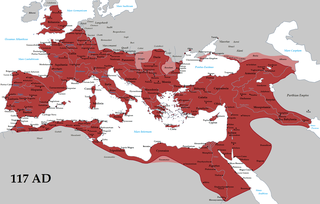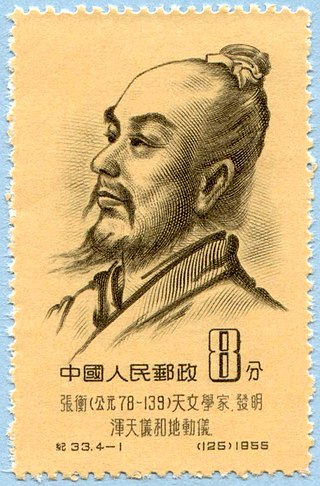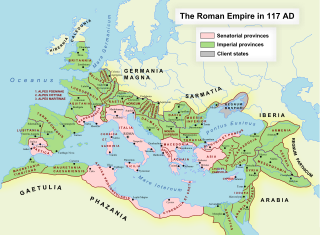
The 60s decade ran from January 1, AD 60, to December 31, AD 69.

The 70s was a decade that ran from January 1, AD 70, to December 31, AD 79.

The 110s was a decade that ran from January 1, AD 110, to December 31, AD 119.

The 120s was a decade that ran from January 1, AD 120, to December 31, AD 129.

Year 125 (CXXV) was a common year starting on Sunday of the Julian calendar. At the time, it was known as the Year of the Consulship of Paullinus and Titius. The denomination 125 for this year has been used since the early medieval period, when the Anno Domini calendar era became the prevalent method in Europe for naming years.

100 (C) was a leap year starting on Wednesday of the Julian calendar, the 100th year of the Common Era (CE) and Anno Domini (AD) designations, the 100th year of the 1st millennium, the 100th and last year of the 1st century, and the 1st year of the 100s decade. As of the start of 100, the Gregorian calendar was 2 days behind the Julian calendar, which was the dominant calendar of the time.

The 130s was a decade that ran from January 1, 130, to December 31, 139.
The 170s decade ran from January 1, 170, to December 31, 179.
Year 115 (CXV) was a common year starting on Monday of the Julian calendar. In the Roman Empire, it was known as the Year of the Consulship of Messalla and Vergilianus. The denomination 115 for this year has been used since the early medieval period, when the Anno Domini calendar era became the prevalent method in Europe for naming years.
Year 116 (CXVI) was a leap year starting on Tuesday of the Julian calendar. At the time, it was known as the Year of the Consulship of Lamia and Vetus. The denomination 116 for this year has been used since the early medieval period, when the Anno Domini calendar era became the prevalent method in Europe for naming years.

Year 117 (CXVII) was a common year starting on Thursday of the Julian calendar. At the time, it was known as the Year of the Consulship of Niger and Apronianus. The denomination 117 for this year has been used since the early medieval period, when the Anno Domini calendar era became the prevalent method in Europe for naming years.
Year 119 (CXIX) was a common year starting on Saturday of the Julian calendar. At the time, it was known as the Year of the Consulship of Hadrianus and Rusticus. The denomination 119 for this year has been used since the early medieval period, when the Anno Domini calendar era became the prevalent method in Europe for naming years.
Year 127 (CXXVII) was a common year starting on Tuesday of the Julian calendar. At the time, it was known as the Year of the Consulship of Rufus and Squilla. The denomination 127 for this year has been used since the early medieval period, when the Anno Domini calendar era became the prevalent method in Europe for naming years.
Year 135 (CXXXV) was a common year starting on Friday of the Julian calendar. At the time, it was known as the Year of the Consulship of Lupercus and Atilianus. The denomination 135 for this year has been used since the early medieval period, when the Anno Domini calendar era became the prevalent method in Europe for naming years.
Year 165 (CLXV) was a common year starting on Monday of the Julian calendar. At the time, it was known as the Year of the Consulship of Orfitus and Pudens. The denomination 165 for this year has been used since the early medieval period, when the Anno Domini calendar era became the prevalent method in Europe for naming years.
Year 175 (CLXXV) was a common year starting on Saturday of the Julian calendar. At the time, it was known as the Year of the Consulship of Piso and Iulianus. The denomination 175 for this year has been used since the early medieval period, when the Anno Domini calendar era became the prevalent method in Europe for naming years.

Year 200 (CC) was a leap year starting on Tuesday of the Julian calendar. At the time, it was known as the Year of the Consulship of Severus and Victorinus. The denomination 200 for this year has been used since the early medieval period, when the Anno Domini calendar era became the prevalent method in Europe for naming years.

Year 300 (CCC) was a leap year starting on Monday of the Julian calendar. At the time, it was known as the Year of the Consulship of Constantius and Valerius. The denomination 300 for this year has been used since the early Middle Ages / Medieval period, when the Latin language term / abbreviation "Anno Domini" for the calendar era became the prevalent universal / worldwide method for naming and numbering years. First beginning in Europe at the end of the Roman Empire (after the split of the Western Roman Empire and Eastern Roman Empire in the early Middle Ages / Medieval period.

Year 180 (CLXXX) was a leap year starting on Friday of the Julian calendar. At the time, it was known as the Year of the Consulship of Rusticus and Condianus. The denomination 180 for this year has been used since the early medieval period, when the Anno Domini calendar era became the prevalent method in Europe for naming years.
The Year 345 (CCCXLV) was a common year starting on Tuesday of the Julian calendar. At the time, it was known as the Year of the Consulship of Amantius and Albinus. The denomination 345 for this year has been used ever since the early medieval period, when the Anno Domini calendar era became the prevalent method in Europe for naming years.










